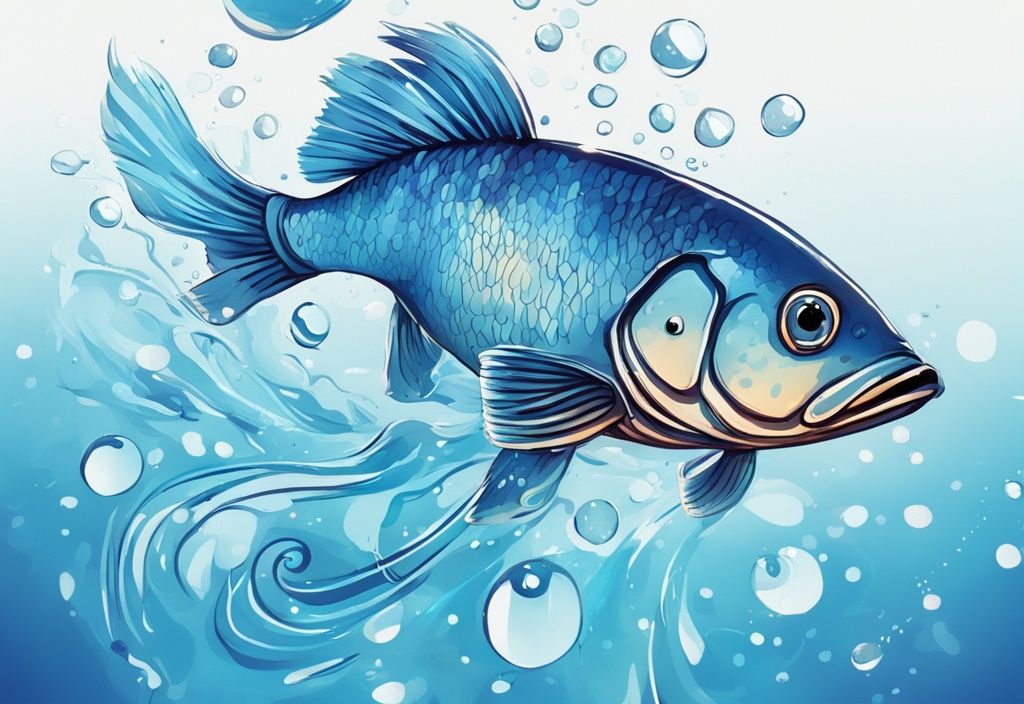Picture this: you’re out on the water, the sun warming your back, when suddenly, a marlin bursts from the ocean, twisting in the air before vanishing beneath the waves. It’s a sight that never gets old, right? But what’s going on beneath the surface? Is it a daring escape from a predator or a strategic move to catch dinner? As an angler, I’ve seen it all, and each leap tells a story. Let’s dive in and explore why these magnificent creatures put on such a show.
Understanding Fish Jumping Behavior
Fish jumping out of the water is one of those mysteries that keeps us anglers on our toes. It’s not just a random splash—there’s a whole world of reasons behind it, each as intriguing as the next. From dodging predators to finding food, fish have some pretty clever tricks up their sleeves. Let’s dive into the fascinating reasons why fish take to the air.
Ever seen a fish leap like it’s auditioning for a high-flying circus act? Often, this acrobatic display is a desperate bid to escape predators. Picture a flying fish, gliding away with its wing-like fins, giving its pursuer the slip. It’s a classic game of cat and mouse, but with a splashy twist.
On the flip side, some fish jump to snag a meal. Think of it as their version of fast food. Predatory fish might leap to catch unsuspecting prey, using surprise as their secret weapon. I’ve watched fish leap vertically to nab insects buzzing above the water, and let me tell you, it’s a sight to behold.

Environmental changes can also send fish skyward. When water temperatures rise or oxygen levels drop, fish might jump to find more comfortable spots. It’s like us seeking a cooler breeze on a hot day. Pollution and poor water quality can prompt these leaps too, as fish search for cleaner, more oxygen-rich waters.
Then there’s the matter of physical prowess. Some fish are built for jumping, with powerful tails and streamlined bodies. Kahawai and billfish, for instance, have the speed and agility to make impressive leaps. And species like mako sharks, with their elevated body temperatures, are the athletes of the ocean, capable of jaw-dropping jumps.
Parasites, too, can drive fish to jump. It’s a natural way to shake off those pesky hitchhikers. And let’s not forget the impact of disturbances like boats. A sudden noise can spook fish, sending them flying. Sometimes, jumping is even a way to communicate, a splashy signal to others of potential danger.
Understanding these behaviors not only adds to our appreciation of fish but also highlights their incredible adaptability. It’s a reminder of the delicate balance they maintain with their environment, a dance of survival that keeps us all hooked.
Main Reasons Why Fish Jump Out of the Water
Escaping Predators
Ever watched a fish leap out of the water and wondered why? One of the main reasons is to dodge predators. Imagine a fish making a quick dash into the air, leaving its pursuer momentarily confused. It’s like a game of hide and seek, but with a splash! Some fish, like the flying fish, take it up a notch by gliding through the air with their wing-like fins. This nifty trick gives them a fighting chance to escape and outsmart their chasers.
Hunting and Feeding
Jumping isn’t just about running away; sometimes, it’s about catching dinner. Picture a mahimahi launching itself to snag an unsuspecting insect hovering above the water. It’s a bold move, using the element of surprise to grab a meal. This leap into the air is a testament to how resourceful and adaptable fish can be when it comes to hunting. Who knew fishing could be so acrobatic?
Environmental Factors
Sometimes, fish jump because their watery world isn’t quite up to snuff. Changes in water temperature or oxygen levels can prompt a fish to leap in search of better conditions. Warmer water might make them more active, while low oxygen could have them gasping for a breath of fresh air. Pollution and poor water quality are also culprits, pushing fish to seek cleaner, healthier environments. It’s like moving to a nicer neighborhood, but with more splashing involved.

Physical Adaptations for Jumping
Some fish are simply built for jumping. Think of those with big, forked tails like kahawai or billfish. They’ve got the speed and power to make impressive leaps. Mako sharks, with their warm body cores, can jump with agility that would make an athlete jealous. And marlin? They’ve got special organs to heat their blood, giving them an extra boost. These adaptations aren’t just cool; they’re evolutionary game-changers that help these fish excel in their airborne antics.
Other Reasons for Jumping
Fish have a few other tricks up their fins when it comes to jumping. Some, like makos and marlin, might leap to shake off pesky parasites. It’s a bit like scratching an itch but with more flair. If you’re curious about aquatic diets, you might wonder, do ducks eat fish in their natural habitats? Environmental disturbances, like a boat passing by, can spook fish into jumping too. And sometimes, it’s all about communication—sending signals to fellow fish or warning of danger. These jumps are as varied as the fish themselves, each with its own story to tell.
Detailed Look at Why Fish Jump
Ever wondered why fish leap out of the water? It’s a fascinating behavior with multiple reasons behind it. Let’s dive into the details and explore the various motivations that drive fish to make these spectacular jumps.
Fish Using Air as a Refuge
Fish often resort to jumping as a survival mechanism when predators close in. Picture this: a school of fish, cornered near the water’s surface, suddenly bursts into the air. This unexpected move can throw predators off their game, making it tough for them to track the fish’s path. By using the air as a temporary refuge, fish gain a crucial edge, boosting their chances of escape and survival. It’s a bit like a high-stakes game of hide and seek, wouldn’t you say?
Jumping to Catch Prey
Jumping isn’t just about dodging danger; it’s also a clever hunting tactic. Predatory fish, like the agile Saratoga, use their leaping skills to snatch prey from overhanging branches. This behavior showcases their adaptability and strategic prowess, allowing them to reach food sources that are otherwise out of reach. It’s a testament to their cunning and resourcefulness—traits any angler can admire.
Water Temperature and Oxygen Levels
Environmental conditions play a big role in why fish jump. Warmer water can crank up fish activity, leading to more frequent leaps. And when oxygen levels in the water drop, some fish might leap out to gulp air, giving their oxygen intake a quick boost. It’s a natural response to environmental stressors, helping fish stay balanced and healthy. Ever noticed this while fishing on a hot day?
Tail and Body Structure
The physical makeup of fish, especially their tails and bodies, is key to their jumping abilities. Species with specialized tails, like those with deeply forked designs, are naturally set up for powerful leaps. Take the kahawai, for example, with its efficient oxygen circulation enhancing its jumping prowess. These anatomical features allow fish to make swift, agile moves, crucial for both escaping predators and catching prey.
Ridding Parasites
Jumping also serves as a way for fish to rid themselves of pesky parasites. Species like makos and marlin are known to leap to shake off unwanted hitchhikers. By doing so, they maintain their health and reduce the risk of infections. It’s a natural cleansing process that highlights the many reasons behind fish jumping behavior, emphasizing its role in their overall well-being. Who knew jumping could be such a versatile tool for fish?
Species-Specific Jumping Behaviors
Salmon Leaping Over Waterfalls
Ever watched a salmon leap over a waterfall? It’s like witnessing a natural marvel. These fish are not just showing off their strength and agility; they’re on a mission. During their spawning migrations, salmon face a gauntlet of obstacles, including towering waterfalls. Their ability to leap over these barriers is crucial. Without it, reaching their upstream breeding grounds would be impossible. This jumping prowess is a testament to their incredible adaptation skills, driven by the instinct to ensure the next generation swims on.
Flying Fish Gliding to Escape
Now, flying fish are a whole different story. Imagine gliding through the air like a bird to escape predators. That’s exactly what these fish do. With a flick of their tails, they launch themselves out of the water, gliding up to 70 meters. Their wing-like fins turn them into aerial acrobats, leaving predators baffled beneath the waves. It’s a brilliant survival strategy, showcasing the diverse ways fish have adapted to their environments. Who knew fish could fly, right?
Saratoga Leaping for Prey on Branches
And then there’s the Saratoga, a fish with a flair for the dramatic. Picture this: you’re a bird or a frog, minding your own business on a branch, when suddenly, a fish leaps out of the water to snag you. The Saratoga’s ability to target prey above the water is nothing short of impressive. This unique hunting strategy not only broadens their menu but also highlights their adaptability. It’s a vivid reminder of the diverse roles fish play in their ecosystems. The Saratoga truly is a versatile predator, making the most of every opportunity, both in and above the water.

FAQs About Fish Jumping Out of the Water
Ever wondered why fish sometimes leap out of their watery homes? It’s a fascinating behavior that can be as thrilling as it is mysterious. Let’s dive into the details and explore some common questions about this aquatic acrobatics.
Do all fish jump out of the water?
Not every fish is a high-flyer. Some species are more prone to jumping, often due to unique adaptations or specific needs. Picture a fish darting out of the water to escape a predator or snag a tasty insect. It’s a survival tactic, not a universal fishy pastime.
Can fish jump out of aquariums?
Oh, absolutely! Fish can and do leap out of aquariums. This usually happens when they’re stressed, perhaps from poor water quality, or when they’re on the hunt for food or a mate. It’s like they’re saying, “Get me outta here!”
Is jumping behavior harmful to fish?
Jumping can be a double-edged sword for our finned friends. While it might help them survive in the wild, it can also lead to injuries or leave them high and dry, quite literally. Imagine a fish stranded out of water—it’s a risky business.
What should I do if my fish jumps out of the tank?
If your fish decides to go for a leap of faith, act fast. Gently scoop it up and return it to the tank. Then, take a moment to check the tank conditions. A stress-free environment is key to keeping your fish happily swimming, not jumping.
Conclusion
Fish jumping out of the water is one of those mysteries that keeps us anglers both puzzled and fascinated. It’s a dance of survival, a response to the ever-changing world beneath the waves. Each leap is like a story unfolding—sometimes it’s about dodging a hungry predator, other times it’s a quest for better waters. Understanding why fish jump out of the water isn’t just for the scientists; it’s a tool for us fishers and conservationists alike. By grasping these behaviors, we can create environments that cater to the natural needs of fish, ensuring their health and well-being.
Out in the wild, jumping is a lifeline. Picture a fish breaking the surface, escaping a predator, using the air as a temporary shield. It’s not just about running away; sometimes it’s a clever tactic for hunting, catching prey off guard. And let’s not forget the environmental factors—water temperature and oxygen levels can push fish to seek cooler, more oxygen-rich spots, especially when pollution messes with their usual haunts.
Then there’s the physical side of things. Some fish are built for jumping, like the kahawai and billfish, with tails and bodies that make them natural acrobats. And those mako sharks? Their higher body temperatures give them an edge, turning them into the athletes of the sea. These adaptations are a testament to the intricate link between a fish’s build and its jumping antics.
For us aquarium enthusiasts, understanding this behavior means creating a home that feels just right for our finned friends. It’s about keeping the water quality top-notch and reducing stressors that might send them leaping. By aligning their environment with their natural behaviors, we contribute to their conservation and ensure they thrive, whether in the wild or in our tanks.


